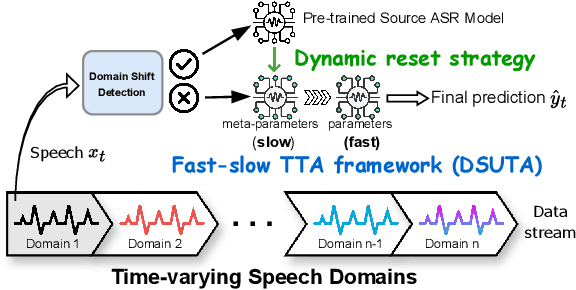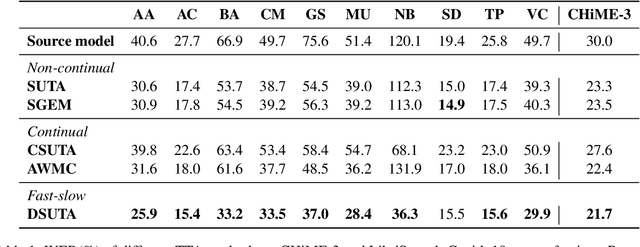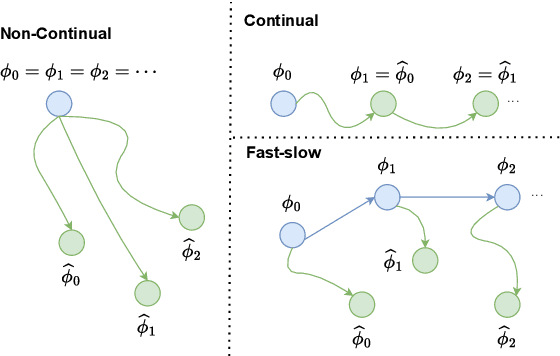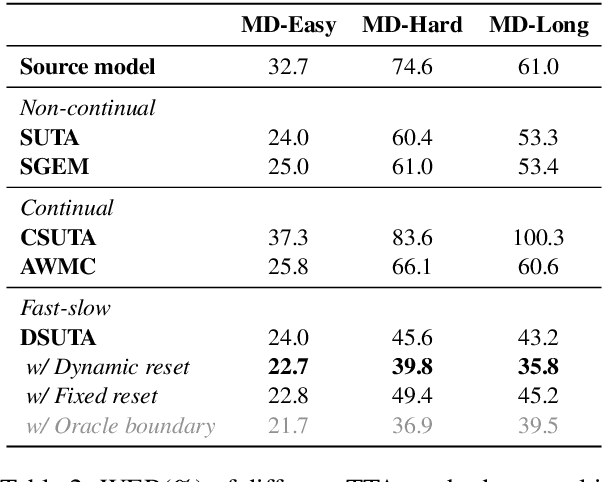Guan-Ting Lin
Full-Duplex-Bench-v2: A Multi-Turn Evaluation Framework for Duplex Dialogue Systems with an Automated Examiner
Oct 09, 2025Abstract:While full-duplex speech agents enable natural, low-latency interaction by speaking and listening simultaneously, their consistency and task performance in multi-turn settings remain underexplored. We introduce Full-Duplex-Bench-v2 (FDB-v2), a streaming framework that integrates with an automated examiner that enforces staged goals under two pacing setups (Fast vs. Slow). FDB-v2 covers four task families: daily, correction, entity tracking, and safety. We report turn-taking fluency, multi-turn instruction following, and task-specific competence. The framework is extensible, supporting both commercial APIs and open source models. When we test full-duplex systems with FDB-v2, they often get confused when people talk at the same time, struggle to handle corrections smoothly, and sometimes lose track of who or what is being talked about. Through an open-sourced, standardized streaming protocol and a task set, FDB-v2 makes it easy to extend to new task families, allowing the community to tailor and accelerate evaluation of multi-turn full-duplex systems.
EMO-Reasoning: Benchmarking Emotional Reasoning Capabilities in Spoken Dialogue Systems
Aug 25, 2025Abstract:Speech emotions play a crucial role in human-computer interaction, shaping engagement and context-aware communication. Despite recent advances in spoken dialogue systems, a holistic system for evaluating emotional reasoning is still lacking. To address this, we introduce EMO-Reasoning, a benchmark for assessing emotional coherence in dialogue systems. It leverages a curated dataset generated via text-to-speech to simulate diverse emotional states, overcoming the scarcity of emotional speech data. We further propose the Cross-turn Emotion Reasoning Score to assess the emotion transitions in multi-turn dialogues. Evaluating seven dialogue systems through continuous, categorical, and perceptual metrics, we show that our framework effectively detects emotional inconsistencies, providing insights for improving current dialogue systems. By releasing a systematic evaluation benchmark, we aim to advance emotion-aware spoken dialogue modeling toward more natural and adaptive interactions.
Full-Duplex-Bench: A Benchmark to Evaluate Full-duplex Spoken Dialogue Models on Turn-taking Capabilities
Mar 06, 2025Abstract:Spoken dialogue modeling introduces unique challenges beyond text-based language modeling, demanding robust turn-taking, backchanneling, and real-time interaction. Although most Spoken Dialogue Models (SDMs) rely on half-duplex processing (handling speech one turn at a time), emerging full-duplex SDMs can listen and speak simultaneously, enabling more natural and engaging conversations. However, current evaluations of such models remain limited, often focusing on turn-based metrics or high-level corpus analyses (e.g., turn gaps, pauses). To address this gap, we present Full-Duplex-Bench, a new benchmark that systematically evaluates key conversational behaviors: pause handling, backchanneling, turn-taking, and interruption management. Our framework uses automatic metrics for consistent and reproducible assessments of SDMs' interactive performance. By offering an open and standardized evaluation benchmark, we aim to advance spoken dialogue modeling and encourage the development of more interactive and natural dialogue systems.
How to Learn a New Language? An Efficient Solution for Self-Supervised Learning Models Unseen Languages Adaption in Low-Resource Scenario
Nov 27, 2024



Abstract:The utilization of speech Self-Supervised Learning (SSL) models achieves impressive performance on Automatic Speech Recognition (ASR). However, in low-resource language ASR, they encounter the domain mismatch problem between pre-trained and low-resource languages. Typical solutions like fine-tuning the SSL model suffer from high computation costs while using frozen SSL models as feature extractors comes with poor performance. To handle these issues, we extend a conventional efficient fine-tuning scheme based on the adapter. We add an extra intermediate adaptation to warm up the adapter and downstream model initialization. Remarkably, we update only 1-5% of the total model parameters to achieve the adaptation. Experimental results on the ML-SUPERB dataset show that our solution outperforms conventional efficient fine-tuning. It achieves up to a 28% relative improvement in the Character/Phoneme error rate when adapting to unseen languages.
Align-SLM: Textless Spoken Language Models with Reinforcement Learning from AI Feedback
Nov 04, 2024



Abstract:While textless Spoken Language Models (SLMs) have shown potential in end-to-end speech-to-speech modeling, they still lag behind text-based Large Language Models (LLMs) in terms of semantic coherence and relevance. This work introduces the Align-SLM framework, which leverages preference optimization inspired by Reinforcement Learning with AI Feedback (RLAIF) to enhance the semantic understanding of SLMs. Our approach generates multiple speech continuations from a given prompt and uses semantic metrics to create preference data for Direct Preference Optimization (DPO). We evaluate the framework using ZeroSpeech 2021 benchmarks for lexical and syntactic modeling, the spoken version of the StoryCloze dataset for semantic coherence, and other speech generation metrics, including the GPT4-o score and human evaluation. Experimental results show that our method achieves state-of-the-art performance for SLMs on most benchmarks, highlighting the importance of preference optimization to improve the semantics of SLMs.
Property Neurons in Self-Supervised Speech Transformers
Sep 07, 2024



Abstract:There have been many studies on analyzing self-supervised speech Transformers, in particular, with layer-wise analysis. It is, however, desirable to have an approach that can pinpoint exactly a subset of neurons that is responsible for a particular property of speech, being amenable to model pruning and model editing. In this work, we identify a set of property neurons in the feedforward layers of Transformers to study how speech-related properties, such as phones, gender, and pitch, are stored. When removing neurons of a particular property (a simple form of model editing), the respective downstream performance significantly degrades, showing the importance of the property neurons. We apply this approach to pruning the feedforward layers in Transformers, where most of the model parameters are. We show that protecting property neurons during pruning is significantly more effective than norm-based pruning.
Continual Test-time Adaptation for End-to-end Speech Recognition on Noisy Speech
Jun 16, 2024



Abstract:Deep learning-based end-to-end automatic speech recognition (ASR) has made significant strides but still struggles with performance on out-of-domain (OOD) samples due to domain shifts in real-world scenarios. Test-Time Adaptation (TTA) methods address this issue by adapting models using test samples at inference time. However, current ASR TTA methods have largely focused on non-continual TTA, which limits cross-sample knowledge learning compared to continual TTA. In this work, we propose a Fast-slow TTA framework for ASR, which leverages the advantage of continual and non-continual TTA. Within this framework, we introduce Dynamic SUTA (DSUTA), an entropy-minimization-based continual TTA method for ASR. To enhance DSUTA's robustness on time-varying data, we propose a dynamic reset strategy that automatically detects domain shifts and resets the model, making it more effective at handling multi-domain data. Our method demonstrates superior performance on various noisy ASR datasets, outperforming both non-continual and continual TTA baselines while maintaining robustness to domain changes without requiring domain boundary information.
Can LLMs Understand the Implication of Emphasized Sentences in Dialogue?
Jun 16, 2024



Abstract:Emphasis is a crucial component in human communication, which indicates the speaker's intention and implication beyond pure text in dialogue. While Large Language Models (LLMs) have revolutionized natural language processing, their ability to understand emphasis in dialogue remains unclear. This paper introduces Emphasized-Talk, a benchmark with emphasis-annotated dialogue samples capturing the implications of emphasis. We evaluate various LLMs, both open-source and commercial, to measure their performance in understanding emphasis. Additionally, we propose an automatic evaluation pipeline using GPT-4, which achieves a high correlation with human rating. Our findings reveal that although commercial LLMs generally perform better, there is still significant room for improvement in comprehending emphasized sentences.
Advancing Large Language Models to Capture Varied Speaking Styles and Respond Properly in Spoken Conversations
Feb 20, 2024Abstract:In spoken dialogue, even if two current turns are the same sentence, their responses might still differ when they are spoken in different styles. The spoken styles, containing paralinguistic and prosodic information, mark the most significant difference between text and speech modality. When using text-only LLMs to model spoken dialogue, text-only LLMs cannot give different responses based on the speaking style of the current turn. In this paper, we focus on enabling LLMs to listen to the speaking styles and respond properly. Our goal is to teach the LLM that "even if the sentences are identical if they are spoken in different styles, their corresponding responses might be different". Since there is no suitable dataset for achieving this goal, we collect a speech-to-speech dataset, StyleTalk, with the following desired characteristics: when two current speeches have the same content but are spoken in different styles, their responses will be different. To teach LLMs to understand and respond properly to the speaking styles, we propose the Spoken-LLM framework that can model the linguistic content and the speaking styles. We train Spoken-LLM using the StyleTalk dataset and devise a two-stage training pipeline to help the Spoken-LLM better learn the speaking styles. Based on extensive experiments, we show that Spoken-LLM outperforms text-only baselines and prior speech LLMs methods.
SpeechDPR: End-to-End Spoken Passage Retrieval for Open-Domain Spoken Question Answering
Jan 24, 2024


Abstract:Spoken Question Answering (SQA) is essential for machines to reply to user's question by finding the answer span within a given spoken passage. SQA has been previously achieved without ASR to avoid recognition errors and Out-of-Vocabulary (OOV) problems. However, the real-world problem of Open-domain SQA (openSQA), in which the machine needs to first retrieve passages that possibly contain the answer from a spoken archive in addition, was never considered. This paper proposes the first known end-to-end framework, Speech Dense Passage Retriever (SpeechDPR), for the retrieval component of the openSQA problem. SpeechDPR learns a sentence-level semantic representation by distilling knowledge from the cascading model of unsupervised ASR (UASR) and text dense retriever (TDR). No manually transcribed speech data is needed. Initial experiments showed performance comparable to the cascading model of UASR and TDR, and significantly better when UASR was poor, verifying this approach is more robust to speech recognition errors.
 Add to Chrome
Add to Chrome Add to Firefox
Add to Firefox Add to Edge
Add to Edge